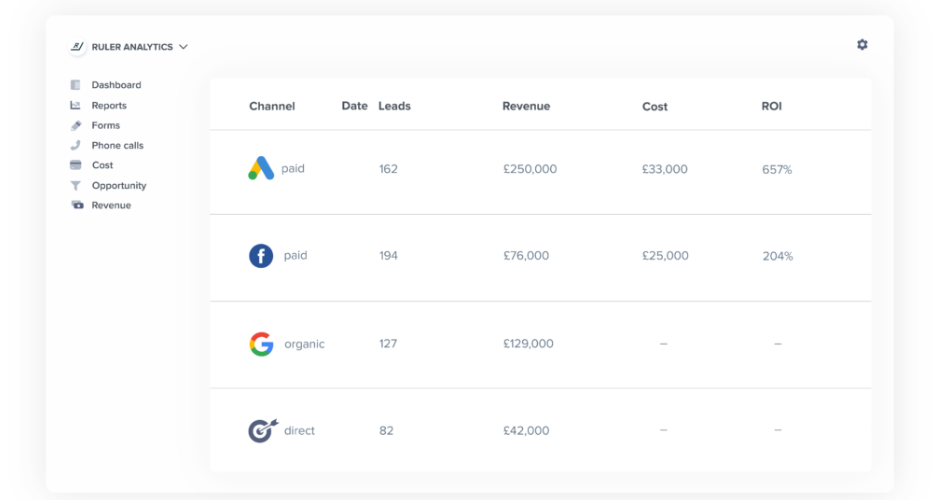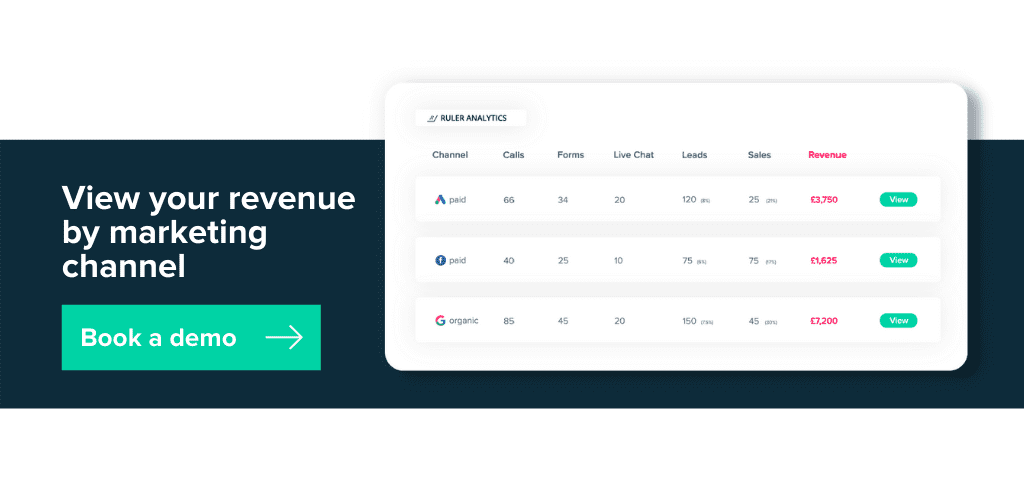Drive higher converting leads and customers for your company with pipeline generation.
Lead generation is no longer the main priority for marketers.
The data backs it up. A recent B2B revenue marketing study found that 82% of marketers are measured on pipeline initiated.
If ‘leads’ are no longer the main goal, what should you focus on instead to measure success and boost revenue?
The answer is simple: pipeline generation.
In this article, we’ll discuss:
Pro Tip
Ruler makes the process of pipeline generation a breeze. It tracks data on a visitor level, allowing you to successfully attribute leads and revenue back to your landing pages across multiple campaigns, ads, keywords and more.
Track where your leads came from with Ruler
So that we’re all on the same page, let’s quickly explain pipeline generation and how it works.
You can think of pipeline generation as an upgrade to lead generation.
The goal of lead generation and pipeline generation is to attract individuals (leads) who are likely to become long-lasting customers.
While they share some similarities, lead generation and pipeline generation aren’t quite the same.
Lead generation focuses on collecting as many leads as possible without considering their quality or buying intent.
Related: 22 tips for B2B lead generation: Advice from experts
Pipeline generation, however, focuses on attracting leads with a higher readiness to buy. It takes lead quality into account to ensure a steady stream of opportunities for sales.
There are many benefits to be gained from pipeline generation, including:
For a long time, marketers have prioritised lead volume over lead quality.
Sounds logical, doesn’t it? The more leads you generate, the faster your revenue will grow?
In most cases, no.
Not all leads are created equal.
Your campaigns, ads and marketing channels all deliver different results.
Take the example below.
| Campaign | Leads | Cost | Cost per lead |
| Campaign 1 | 25 | £500 | £20.00 |
| Campaign 2 | 5 | £500 | £100.00 |
| Campaign 3 | 12 | £500 | £41.66 |
Considering only lead and ad cost data, ad campaign one is the clear winner. For the same cost as campaign two, it’s delivered 5x more leads.
With these results, any marketer wanting to make a big impact on revenue would take the budget away from campaign two and allocate it to campaign one, right?
Let’s not get ahead of ourselves just yet.
Before we make any final decisions, let’s add opportunity and revenue data to see how successful these campaigns really are.
| Campaign | Leads | Cost | CPL | Opportunites | Revenue |
| Campaign 1 | 25 | £500 | £20.00 | 8 | £1,592 |
| Campaign 2 | 5 | £500 | £100.00 | 4 | £1,996 |
| Campaign 3 | 12 | £500 | £41.66 | 3 | £897 |
By adding opportunity and revenue data, we can now see that campaign two had the best impact on the business despite generating a lower volume of leads.
It’s for this exact reason that marketers need to stop looking at lead generation and implement pipeline generation.
With pipeline generation, marketers can see how their marketing efforts resonate with leads and opportunities. They can invest budget in the right areas and prioritise the marketing channels that offer the highest returns.
Without a doubt, pipeline generation should be among the top priorities for businesses. While pipeline generation offers immense value, marketers are struggling to get to grips with it due to the following reasons:
If we’ve learned anything from our clients, it’s that pipeline generation is difficult without the right tools.
To measure pipeline generation success, most marketers will rely on Google Analytics.
Related: 6 ways to track leads in Google Analytics
Our data backs it up. 90% of marketers consider Google Analytics their go-to choice for marketing measurement.
The problem with Google Analytics as a standalone product is that you can’t track “people”.
Google Analytics only tracks unique user IDs and doesn’t capture personal information such as names or email addresses.
Related: How to track individual users in Google Analytics
Without identifiable data in Google Analytics, it’s impossible to track where your biggest opportunities originated and determine marketing’s impact on pipeline generation.
Sales and marketing are often considered two separate functions.
The marketing funnel starts with the awareness stage and ends when visitors convert into leads.
Related: Guide to sales and marketing alignment
Once marketing has done its job, the sales funnel kicks in and ends when a prospect agrees to a deal or makes a sale.
As these teams work in silos and focus on different stages of the funnel, data isn’t transferred between them, and the process of pipeline generation becomes impossible.
Think about it like this.
If the marketing team doesn’t know what drives the most qualified leads and opportunities, how can they tailor their marketing efforts to reach a similar audience?
The same goes for the sales team. If the sales team can’t track where leads are coming from, how can they personalise their pitch to convert more opportunities into revenue?
Now that we’ve covered the benefits and challenges, it’s time to dig into the steps to creating and executing a pipeline generation strategy. Building an effective pipeline generation strategy is incredibly important. The more quality leads you can create for your sales team, the easier it’ll be to grow your revenue.
1. Align sales and marketing teams
2. Integrate your tools for end-to-end visibility of your pipeline
2. Build a customer profile to pin down your ideal target audience
4. Track marketing’s impact on pipeline and revenue metrics
5. Be prepared to change
To build a successful pipeline generation strategy, you need to ensure your sales and marketing teams are aligned from the very beginning.
When everyone has access to the same insight, it’s easier to determine what is and isn’t working to drive pipeline activity.
We have a complete guide on how to align sales and marketing teams, but here are a few things you can do to get started:
The tips above are key to aligning your sales and marketing teams, but they can only take you so far.
To streamline your departments and gain visibility over your pipeline, you need to ensure a flow of data, and the best way to achieve this is by using the right tools.
45% of marketers and sales professionals agree that having the correct tools helps achieve sales and marketing alignment.
We’re lucky to have Ruler to help us track customer journeys and understand which leads are converting into sales.
Related: How to track view customer journey with Ruler
Ruler is a marketing attribution tool that tracks each anonymous visitor to our website over multiple sessions, traffic sources and keywords.
When a visitor converts into a lead, the data is captured via form fill, phone call or live chat. Ruler matches the user’s conversion details with their marketing touchpoints and sends this data to our CRM.

This integration allows us to enrich our CRM leads with attribution data and track what marketing efforts are positively impacting our pipeline and revenue generation. More on how Ruler tracks leads.
Pro Tip
Want to see Ruler in action? Book a demo and learn Ruler can improve reporting and enhance your pipeline generation strategy.
Book a free demo of Ruler
Once you integrate the right tools, you can start to segment your data and determine what factors make up a good customer.
You can start by looking for patterns and similarities around your highest converting customers and use that information to track down your ideal target audience.
For example, you might find customers with a particular job title are worth considerably more money and have a greater impact on your pipeline.
The marketing team can then use this data to personalise communications and products to meet the needs of your ideal target audience.
If you were to use a tool like Ruler, you could go one step further.

Using Ruler’s attribution data, you can track where your highest converting customer came from and use that insight to build campaigns to attract a similar pool of leads and opportunities.
At this point, you should know who to target and which channels to use.
It’s important that you consistently measure the success of your campaigns to ensure the effectiveness of your pipeline generation strategy.
If you aren’t measuring your pipeline, how can you improve it?
Historically, marketers have used the following metrics to demonstrate the value of their contributions:
While increased traffic, brand awareness, and engagement are all wonderful benefits of marketing, they don’t highlight how marketing impacts pipeline activity.
Pipeline metrics help connect your marketing efforts with pipeline activity and allow you to demonstrate your impact on qualified leads, opportunities and revenue.
There are many pipeline metrics you can track, but here are some of the most useful:
As you change, grow, and expand, so will your target audience.
The key to a long and successful pipeline generation is consistently refreshing your customer insights to verify whether or not your target audience profile is still valuable.
You must regularly reevaluate your internal customer data to ensure that you’re targeting the right audience.
If your target audience profile doesn’t match the common characteristics of your highest converting customers, it might be time to go back to the drawing board.
Long gone are the days of generating high volume, low-quality leads.
Pipeline generation is here to stay.
You can either get on board or lose out to competitors.
Remember, Ruler can play a huge role in creating and executing a successful pipeline generation strategy.
Ruler tracks your full pipeline, allowing you to track how your marketing efforts are performing and determine which leads are converting into paying customers.
You can learn more about how Ruler helps you track full customer journeys. Or, if you’d like to see Ruler action, reach out by requesting a demo.
